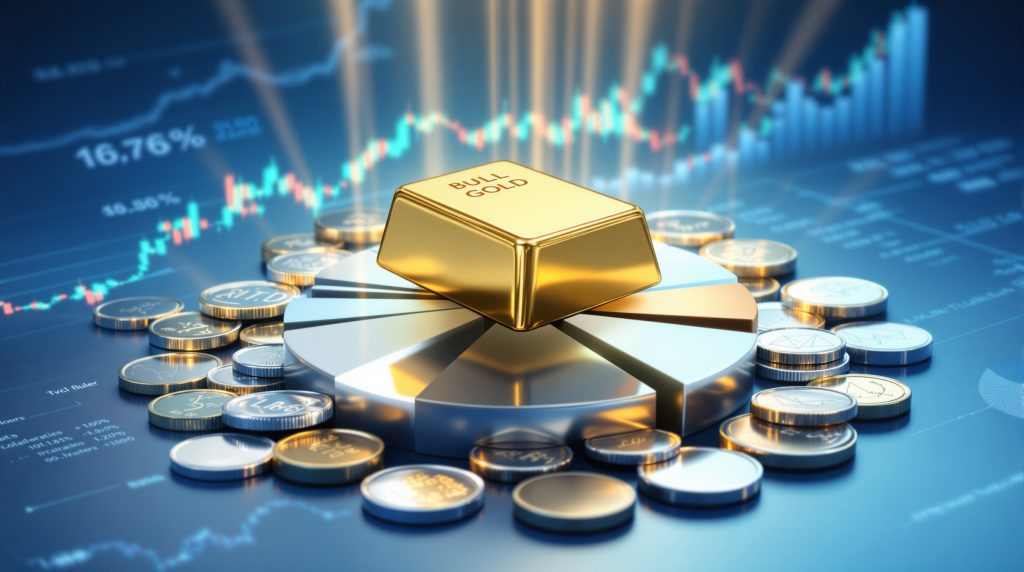Strategic Precious Metals Investing: Building a Resilient Portfolio
Precious metals have withstood the test of time as foundational assets for preserving wealth across civilizations. In today's volatile financial landscape, these tangible commodities provide unique advantages that complement conventional investment vehicles. With gold recently reaching unprecedented price levels exceeding $3,600 per ounce and silver approaching $41, investors face both promising opportunities and significant considerations when integrating these precious metals investment strategies into their portfolios.
The current precious metals market presents fascinating dynamics. Gold has broken through multiple resistance points to reach record highs, while silver has emerged from what technical analysts describe as a multi-decade chart pattern suggesting significant growth potential. Meanwhile, central banks worldwide have accelerated their gold purchasing activities, creating strong demand fundamentals despite institutional investors in Western markets remaining hesitant.
How Do Precious Metals Fit Into Modern Investment Strategies?
Throughout financial history, precious metals have consistently demonstrated their value during periods of economic uncertainty. Despite technological advancements and the rise of digital assets, physical gold and silver continue to attract investors seeking stability amid market turbulence.
The appeal of precious metals stems from their unique position in the financial ecosystem—they stand apart from traditional paper assets by offering tangible value that exists independently of the banking system. This characteristic becomes particularly valuable during periods of systemic stress when confidence in financial institutions wavers.
Understanding the Current Precious Metals Landscape
The precious metals market is experiencing remarkable developments that deserve attention from serious investors:
- Gold has shattered previous resistance levels, demonstrating powerful upward momentum
- Silver has broken through long-term technical barriers, potentially signaling the beginning of a significant silver market squeeze
- Central banks globally have shifted from net sellers to aggressive buyers of gold reserves
- Physical premiums for retail products have compressed to historically low levels
- Institutional investment participation remains muted despite price appreciation, suggesting potential for additional capital inflows
These conditions create a unique environment where physical precious metals remain accessible despite substantial price increases. The disconnect between retail premiums and spot prices presents opportunities for investors to establish positions with minimal transaction costs compared to historical norms.
Why Are Precious Metals Considered Essential Portfolio Components?
The enduring value of precious metals as investment vehicles stems from their proven performance characteristics across diverse economic conditions. Unlike modern financial assets, gold and silver have demonstrated their worth through centuries of monetary history.
Proven Wealth Preservation Characteristics
Precious metals offer multiple advantages that have attracted investors throughout history:
- Millennium-spanning track record of maintaining purchasing power across civilizations
- Natural counterbalance against currency devaluation and inflationary pressures
- Historical tendency to move independently or opposite to conventional financial assets
- Consistent performance during periods of financial system stress
- Protection against systemic risks that can impact traditional investments simultaneously
This wealth preservation function becomes increasingly important as monetary policies worldwide continue to favor currency expansion over fiscal discipline. As central banks maintain accommodative policies and governments increase debt levels, the fundamental case for precious metals investment strategies strengthens.
Diversification Benefits Beyond Traditional Assets
Modern portfolio theory emphasizes the importance of holding uncorrelated assets to reduce overall volatility. Precious metals excel in this capacity:
- Historical tendency to perform differently from stocks and bonds during market downturns
- Portfolio volatility reduction through inclusion of assets with different behavioral patterns
- Protection against extreme "tail risk" events that can devastate conventional portfolios
- Store of value independent of financial system counterparties
- Physical assets existing outside digital financial infrastructure vulnerabilities
The correlation benefits become most apparent during periods of market stress, when many traditional diversification strategies fail as assets move downward in unison. During these critical periods, precious metals often maintain their value or appreciate, providing essential portfolio protection.
What Allocation Percentage Makes Sense for Precious Metals?
Determining the appropriate allocation to precious metals requires balancing multiple factors including risk tolerance, investment timeline, and existing portfolio composition. While there's no universal formula, several frameworks can guide decision-making.
Conservative Portfolio Allocation Models
Financial professionals typically suggest several approaches to precious metals allocation:
- Conventional financial advisors often recommend a 5-10% baseline allocation
- Investors with heightened concerns about monetary stability may consider 10-20%
- Distribution between gold and silver depends on growth objectives and risk preferences
- Periodic rebalancing becomes important after significant price movements
- Life-stage considerations may influence allocation decisions for retirement planning
These allocation models provide starting points rather than rigid formulas. Individual circumstances, including existing portfolio composition and personal risk assessment, should inform the final decision.
Strategic Considerations for Allocation Decisions
Several factors should influence allocation decisions beyond standard percentages:
- Current economic indicators including inflation measurements and forecasts
- Individual risk tolerance assessment and investment time horizon
- Existing portfolio composition and correlation analysis
- Liquidity requirements and emergency reserve considerations
- Tax efficiency and estate planning implications
Investors should view precious metals allocation as a dynamic rather than static decision. Regular portfolio reviews should include reassessment of metals exposure based on changing market conditions and personal circumstances.
Which Precious Metals Offer the Best Investment Potential?
The precious metals family includes several elements with distinct investment characteristics. Understanding the unique attributes of each metal helps investors select the options best aligned with their investment objectives.
Gold: The Foundation of Precious Metals Investing
Gold remains the cornerstone precious metal investment for several compelling reasons:
- Primary wealth preservation vehicle with the lowest volatility among precious metals
- Sustained central bank demand creating significant price support mechanisms
- Annual production representing only a small percentage of above-ground supply
- Limited industrial consumption reducing vulnerability to economic downturns
- Consistent gold market performance across diverse economic environments throughout history
These characteristics make gold the natural starting point for precious metals investors, particularly those primarily concerned with wealth preservation rather than growth potential.
Silver: The Growth-Oriented Precious Metal
Silver offers a different investment profile that appeals to those seeking higher potential returns:
- Unique dual role combining monetary history with extensive industrial applications
- Higher volatility profile creating opportunities for greater percentage gains
- Current gold-to-silver ratio historically elevated, suggesting potential mean reversion
- Expanding industrial demand from renewable energy, electronics and medical sectors
- Limited investment-grade inventory compared to total production
Silver's industrial demand component creates both challenges and opportunities. Economic downturns can temporarily reduce industrial consumption, but long-term technological trends support expanding uses for silver's unique properties.
Platinum and Palladium: Specialized Industrial Metals
The platinum group metals present more specialized investment considerations:
- Predominantly industrial applications with more limited monetary history
- Highly concentrated production sources creating potential supply vulnerabilities
- Automotive catalyst applications historically driving significant demand
- Emerging hydrogen economy potentially creating new demand sources
- Higher volatility and risk profile compared to gold and silver
These metals typically appeal to more sophisticated investors comfortable with higher volatility and willing to research specialized industrial demand factors.
What Are the Most Effective Ways to Own Precious Metals?
The method of ownership significantly impacts the risk profile, liquidity, and potential returns of precious metals investments. Each approach offers distinct advantages and limitations.
Physical Ownership: Coins, Bars, and Bullion
Direct physical ownership represents the most straightforward approach to precious metals investing:
- Complete elimination of financial system counterparty risk
- Size options ranging from fractional grams to multiple kilograms
- Premium considerations varying significantly between product categories
- Storage and insurance requirements adding to total ownership costs
- Liquidity factors influenced by product recognition and dealer relationships
Modern technology has expanded accessibility to physical ownership through fractional purchase programs allowing investments starting around $50 with minimal premiums. These innovations address traditional barriers to entry for smaller investors.
Paper Alternatives: ETFs, Mining Stocks, and Funds
Various financial instruments provide exposure to precious metals prices without physical possession:
- Exchange-traded funds tracking metal prices with convenient trading and storage
- Mining company stocks offering operational leverage to metal price movements
- Royalty and streaming companies providing hybrid exposure models
- Futures and options contracts for sophisticated investors seeking leverage
- Digital platforms enabling fractional ownership with physical backing
These alternatives eliminate storage concerns but introduce varying degrees of counterparty risk and potential tracking error compared to physical metal performance.
Retirement Account Integration Strategies
Incorporating precious metals into retirement planning requires understanding specific account structures:
- Self-directed IRA options enabling physical metals ownership within retirement accounts
- Tax advantages of metals holdings within qualified retirement plans
- Required minimum distribution considerations for physical assets
- Custodian selection criteria and fee structure evaluation
- Estate planning implications for metals held in retirement structures
The tax treatment of precious metals varies significantly between retirement and non-retirement accounts, creating important planning considerations for allocation decisions.
How Can Investors Avoid Common Precious Metals Pitfalls?
The precious metals market includes certain risks and potential pitfalls that informed investors can navigate successfully with proper preparation.
Selecting Reputable Dealers and Custodians
The foundation of successful precious metals investing begins with selecting trustworthy partners:
- Comprehensive due diligence on dealer history, reputation, and customer experiences
- Transparency assessment regarding pricing structures and premium policies
- Storage option evaluation including security protocols and insurance coverage
- Verification of insurance policies and documentation requirements
- Customer service reputation and clearly defined buyback procedures
The World Gold Council study indicated that approximately 75-80% of investors believe gold should be in their portfolios, but only about 25% actually own it. The primary reasons cited include uncertainty about dealer trustworthiness and lack of knowledge about getting started.
Understanding Premium Structures and Market Dynamics
Price awareness prevents costly mistakes when transacting in precious metals:
- Relationship between spot market prices and retail product costs
- Premium variations across different product categories and sizes
- Volume purchase advantages and strategies for larger acquisitions
- Market timing considerations and their limitations
- Emotional discipline during periods of price volatility
Current market conditions feature unusually compressed premiums, creating favorable entry opportunities compared to historical norms.
Balancing Security and Accessibility
Physical metals ownership requires thoughtful security planning:
- Home storage considerations including appropriate security systems
- Third-party depository options with varying accessibility profiles
- Insurance requirements and documentation for different storage methods
- Emergency access protocols for authorized individuals
- Jurisdictional diversification strategies for larger holdings
The optimal security approach balances protection against unauthorized access with reasonable accessibility for the legitimate owner during various scenarios.
When Is the Right Time to Buy Precious Metals?
Timing decisions represent one of the most challenging aspects of precious metals investing, with different approaches offering distinct advantages.
Market Timing vs. Dollar-Cost Averaging
Two primary approaches dominate timing strategies for precious metals acquisitions:
- Historical challenges of precisely timing precious metals market movements
- Systematic purchasing program benefits reducing emotional decision-making
- Price target establishment for incremental position building
- Allocation-based rebalancing triggers maintaining desired portfolio percentages
- Psychological advantages of methodical acquisition approaches
Many investors who hesitated to purchase gold at $1,800 or $2,400 now face the same decision at $3,600, highlighting the limitations of waiting for "pullbacks" during sustained uptrends.
Economic Indicators That Influence Timing Decisions
Several fundamental factors provide context for timing considerations:
- Real interest rate environments and their historical correlation to metals prices
- Currency strength measurement and trend analysis
- Inflation expectations versus official inflation measurements
- Geopolitical risk assessment and potential impact scenarios
- Technical price pattern analysis including support and resistance levels
While these indicators provide valuable context, they rarely offer precise timing signals, reinforcing the value of systematic approaches for most investors.
How Are Global Central Banks Approaching Precious Metals?
Central bank activity in the precious metals markets has undergone a profound shift in recent years, creating significant implications for private investors.
Strategic National Reserve Diversification
Government institutions worldwide have dramatically changed their approach to gold reserves:
- Transformation from net sellers to aggressive purchasers since 2010
- European central bank initiatives to repatriate nationally owned gold
- BRICS nations implementing coordinated gold acquisition strategies
- De-dollarization implications for long-term precious metals demand
- Price support mechanisms resulting from sovereign wealth diversification
This shift from institutional selling to buying represents a fundamental change in market dynamics compared to previous decades.
Middle Eastern Sovereign Wealth Diversification
Oil-producing nations have demonstrated increasing interest in precious metals:
- Saudi Arabian financial institutions entering the silver market
- Resource-rich nations seeking diversification beyond petroleum reserves
- Long-range economic planning for reduced hydrocarbon dependency
- Strategic metal accumulation complementing monetary reserves
- Regional geopolitical factors influencing acquisition strategies
These sovereign wealth initiatives potentially create significant additional demand from institutional buyers with extremely long investment horizons.
What Tax Considerations Apply to Precious Metals Investments?
Tax planning represents an essential but often overlooked aspect of precious metals investing with significant impact on net returns.
Capital Gains Treatment and Reporting Requirements
The tax treatment of precious metals differs from many other investments:
- Long-term versus short-term capital gains classification criteria
- Collectible tax rate application to physical precious metals
- Reporting requirements for transactions exceeding specific thresholds
- Elimination of like-kind exchange provisions for precious metals
- State-level taxation variations including potential sales tax implications
These complex considerations make tax planning an essential component of comprehensive gold investment strategies.
Strategic Tax Planning for Metal Investors
Several approaches can optimize the tax efficiency of precious metals holdings:
- Strategic timing of liquidations to manage tax consequences
- Charitable giving strategies utilizing appreciated metals
- Estate planning considerations including potential basis step-up benefits
- Business entity structure evaluation for larger holdings
- International considerations for investors with global presence
Consultation with tax professionals familiar with precious metals taxation helps investors navigate these specialized considerations.
How Can Beginners Start Investing in Precious Metals?
New investors can establish successful precious metals portfolios by following structured approaches that build knowledge and confidence.
First Steps for New Precious Metals Investors
Beginning a precious metals investment journey requires several fundamental steps:
- Educational resource identification and learning material assessment
- Initial focus on recognized, highly liquid products with minimal premiums
- Relationship development with established, reputable dealers
- Understanding of authentication methods and verification procedures
- Expectation setting based on record gold price analysis
Technology innovations have significantly reduced barriers to entry, with online platforms now enabling purchases as small as $50 with minimal premiums.
Building a Systematic Acquisition Strategy
Consistent approach development supports long-term success:
- Budget allocation for regular precious metals purchases
- Product diversification across different metal types and formats
- Storage solution implementation appropriate to holdings
- Record-keeping system development for inventory management
- Price monitoring without emotional reaction to short-term fluctuations
This methodical approach helps investors build meaningful positions over time while minimizing the impact of market volatility on acquisition decisions.
FAQ: Common Questions About Precious Metals Investing
Are precious metals too expensive to buy at current prices?
While precious metals have reached record nominal prices, their relative value compared to monetary expansion, government debt levels, and other asset classes suggests continued upside potential. Historical patterns demonstrate that waiting for significant pullbacks often results in missed opportunities, as evidenced by gold's steady climb from $1,800 to over $3,600 in recent years.
How can investors purchase precious metals with smaller budgets?
Modern technology has created numerous options for fractional ownership, including online platforms allowing purchases as small as $50 with minimal premiums. These solutions provide accessibility to precious metals investing without requiring large capital outlays for full ounces.
What storage options exist for physical precious metals?
Investors can choose between personal storage (home safes, hidden storage), bank safe deposit boxes (with insurance limitations), and professional depositories (fully insured, segregated storage). Each option presents different tradeoffs between accessibility, security, and cost.
How liquid are precious metals investments?
Physical precious metals maintain excellent liquidity through established dealer networks worldwide. Standard products like American Eagles, Canadian Maple Leafs, and recognized bars command the strongest secondary markets with the tightest bid-ask spreads.
What percentage of a portfolio should be allocated to precious metals?
Conservative financial advisors typically recommend 5-10% allocation, while those concerned about monetary stability or inflation might suggest 10-20%. The appropriate allocation depends on individual risk tolerance, economic outlook, and gold price forecast considerations.
Ready to Discover the Next Major Mineral Opportunity?
Stay ahead of the market with real-time alerts on significant ASX mineral discoveries through Discovery Alert's proprietary Discovery IQ model. Visit our discoveries page to understand how major mineral findings can transform your investment portfolio and deliver exceptional returns.




